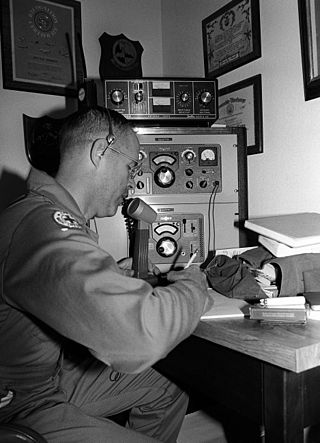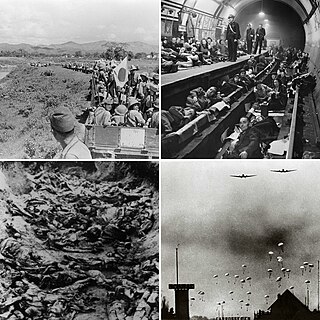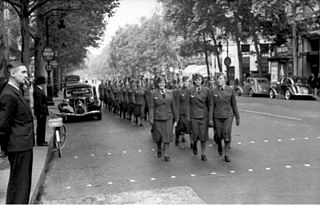
Blitzkrieg is a word used to describe a combined arms surprise attack using a rapid, overwhelming force concentration that may consist of armored and motorized or mechanized infantry formations, together with artillery, air assault and close air support, with intent to break through the opponent's lines of defense, dislocate the defenders, unbalance the enemies by making it difficult to respond to the continuously-changing front, and defeat them in a decisive Vernichtungsschlacht: a battle of annihilation.

The Luftwaffe was the aerial-warfare branch of the German Wehrmacht before and during World War II. Germany's military air arms during World War I, the Luftstreitkräfte of the Imperial Army and the Marine-Fliegerabteilung of the Imperial Navy, had been disbanded in May 1920 in accordance with the terms of the 1919 Treaty of Versailles which banned Germany from having any air force.

The Hitler Youth was the youth organisation of the Nazi Party in Germany. Its origins date back to 1922 and it received the name Hitler-Jugend, Bund deutscher Arbeiterjugend in July 1926. From 1936 until 1945, it was the sole official boys' youth organisation in Germany and it was partially a paramilitary organisation. It was composed of the Hitler Youth proper for male youths aged 14 to 18, and the German Youngsters in the Hitler Youth for younger boys aged 10 to 14.

GeneralfeldmarschallAlbert Kesselring was a German military officer and convicted war criminal who served in the Luftwaffe during World War II. In a career which spanned both world wars, Kesselring became one of Nazi Germany's most highly decorated commanders.

The League of German Girls or the Band of German Maidens was the girls' wing of the Nazi Party youth movement, the Hitler Youth. It was the only legal female youth organization in Nazi Germany.
This is a list of words, terms, concepts, and slogans that have been or are used by the German military. Ranks and translations of nicknames for vehicles are included. Also included are some general terms from the German language found frequently in military jargon. Some terms are from the general German cultural background, others are given to show a change that was made before or after the Nazi era. Some factories that were the primary producers of military equipment, especially tanks, are also given.

Auxiliaries are support personnel that assist the military or police but are organised differently from regular forces. Auxiliary may be military volunteers undertaking support functions or performing certain duties such as garrison troops, usually on a part-time basis. Unlike a military reserve force, an auxiliary force does not necessarily have the same degree of training or ranking structure as regular soldiers, and it may or may not be integrated into a fighting force. Some auxiliaries, however, are militias composed of former active duty military personnel and actually have better training and combat experience than their regular counterparts.

Wilhelm Emanuel Burgdorf was a German general during World War II who served as a commander and staff officer in the German Army. In October 1944, Burgdorf assumed the role of the chief of the Army Personnel Office and chief adjutant to Adolf Hitler. In this capacity, he played a key role in the forced suicide of Field Marshal Erwin Rommel. Burgdorf committed suicide in the Führerbunker on 2 May 1945 at the conclusion of the Battle of Berlin.

Jutta Rüdiger was a German psychologist and head of the Nazi Party's female youth organisation, the League of German Girls, from 1937 to 1945.

This is a timeline of World War II events that took place in 1940, the first full year of the second global war of the 20th century.

This is a timeline of events that stretched over the period of World War II in 1941, marked also by the beginning of Operation Barbarossa on the Eastern Front.

The Wehrmacht were the unified armed forces of Nazi Germany from 1935 to 1945. It consisted of the Heer (army), the Kriegsmarine (navy) and the Luftwaffe. The designation "Wehrmacht" replaced the previously used term Reichswehr and was the manifestation of the Nazi regime's efforts to rearm Germany to a greater extent than the Treaty of Versailles permitted.

European countries have had varying policies that confine women and military service or the extent of their participation in the national armed services of their respective countries, especially combatant roles in armed conflicts or hostile environments. While most of the countries have always allowed women to participate in military activities involving no direct aggression with the enemy, most began seeing the value of servicewomen in the armed services during the First World War when they began losing unprecedented numbers of servicemen. In the modern era, many of the European countries allow women to voluntarily pursue a career path or profession in the national armed services of their country as well as permit conscription equality, with minimal or no restrictions at all.

Women took on many different roles during World War II, including as combatants and workers on the home front. The war involved global conflict on an unprecedented scale; the absolute urgency of mobilizing the entire population made the expansion of the role of women inevitable, although the particular roles varied from country to country. Millions of women of various ages were injured or died as a result of the war.

Günter Luther was a German admiral who became Inspector of the Navy and Deputy Supreme Allied Commander Europe for NATO. During World War II, he served as a military pilot in the Kriegsmarine and a paratrooper in the Luftwaffe. After the war, he joined the newly founded West German Bundesmarine in 1956.
In World War II, children frequently fought in both the Allied and Axis forces.
Luftwaffe personnel structure consisted of two broad categories, Wehrmachtangehörige or members of the armed forces, and Wehrmachtgefolge or auxiliaries of the armed forces.
The German Youth in Slovakia was a youth organization in the Second World War Slovak Republic. The organization functioned as the youth wing of the German Party. DJ was modelled after the Hitler Youth in the German Reich. The leader (Landesleiter) of DJ was F. Klug.

Wehrmachthelferin was the name for girls and young women who served during the Second World War with the German Wehrmacht as auxiliaries.
The Ranks and insignia of German Women's Auxiliary Services were the ranks given to women who served in the German military and paramilitary forces during World War II.

















